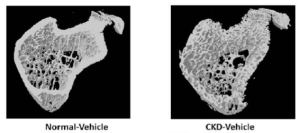One of the lesser appreciated complications of chronic kidney disease (CKD), to those outside of the field, is the dramatic effects on bone health. Fracture rates in folks with CKD are several-fold higher, as are the rates of mortality associated with fracture, compared to the general population. A recent paper in JBMR highlights the idea that CKD has a dramatic effect on cortical bone – with really no effect on trabecular bone. This is district from what most think of for conditions such as post-menopausal bone loss – where dramatic loss of trabecular bone is most notable. Studying individuals with various causes of CKD, the authors used high-resolution CT of the distal radius and tibia to measure properties at baseline and then after ~ 1.5 years. The most striking finding (Figure 1) was that at both the radius and tibia there was an increase of ~ 4% cortical porosity per year. Trabecular bone was essentially unchanged. Those patients on dialysis had even greater rates of porosity increase compared to non-dialysis patients. Although several correlations were assessed to look for biomarkers of cortical porosity – nothing really popped out.
These clinical data are a nice clinical confirmation of our ongoing work in an animal model of CKD. We have found the cortex is where the action is – with the trabecular bone, at least in the tibia, being spared at the expense of the cortex (see image). Always good when the preclinical work actually translates to the clinic!
